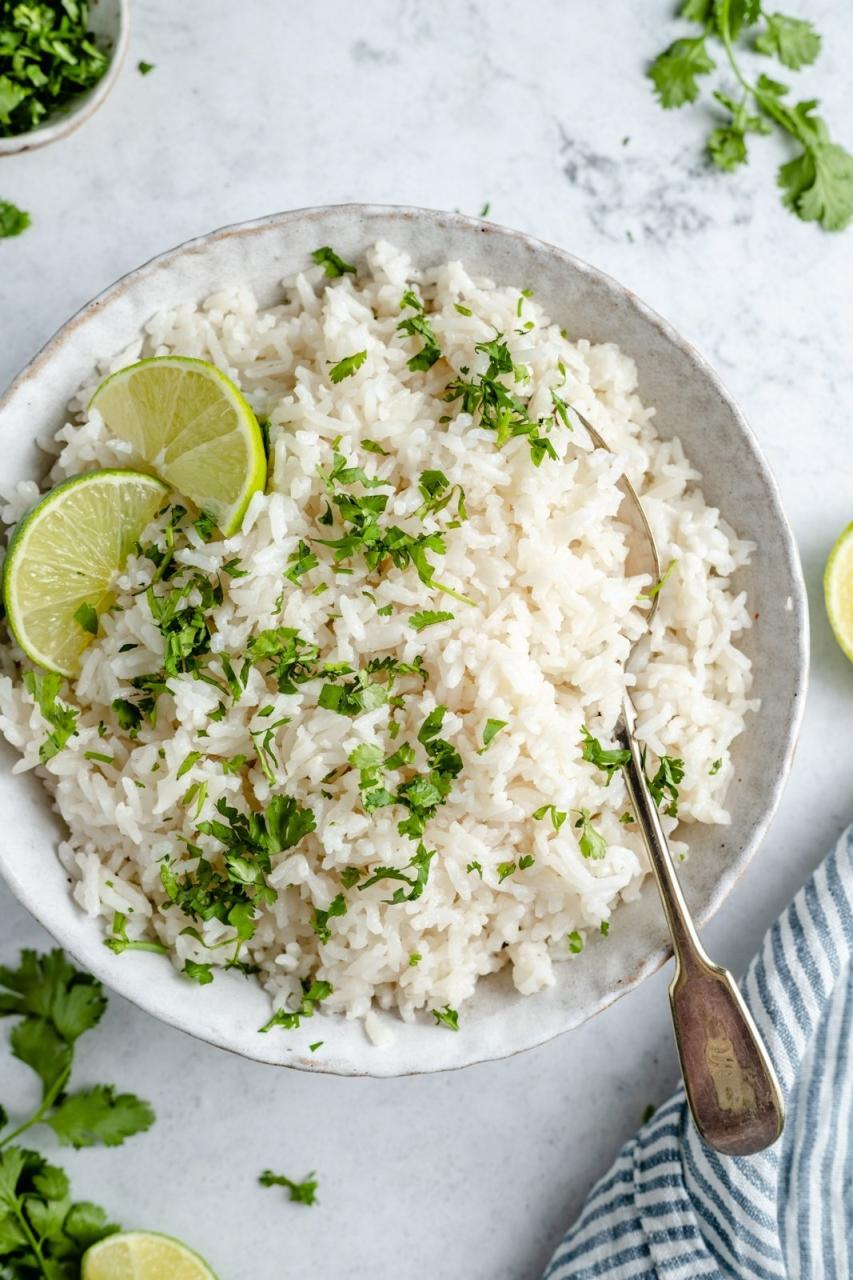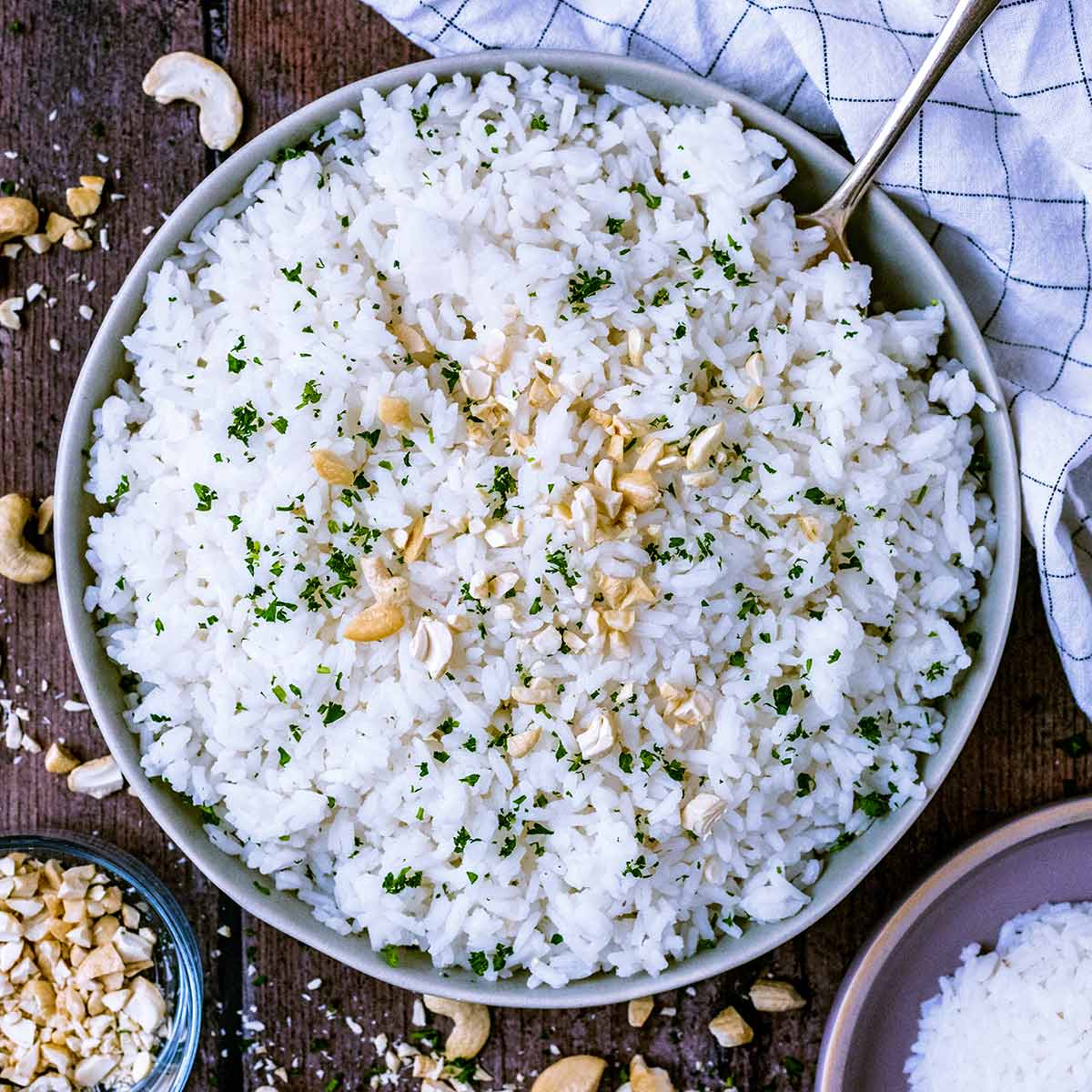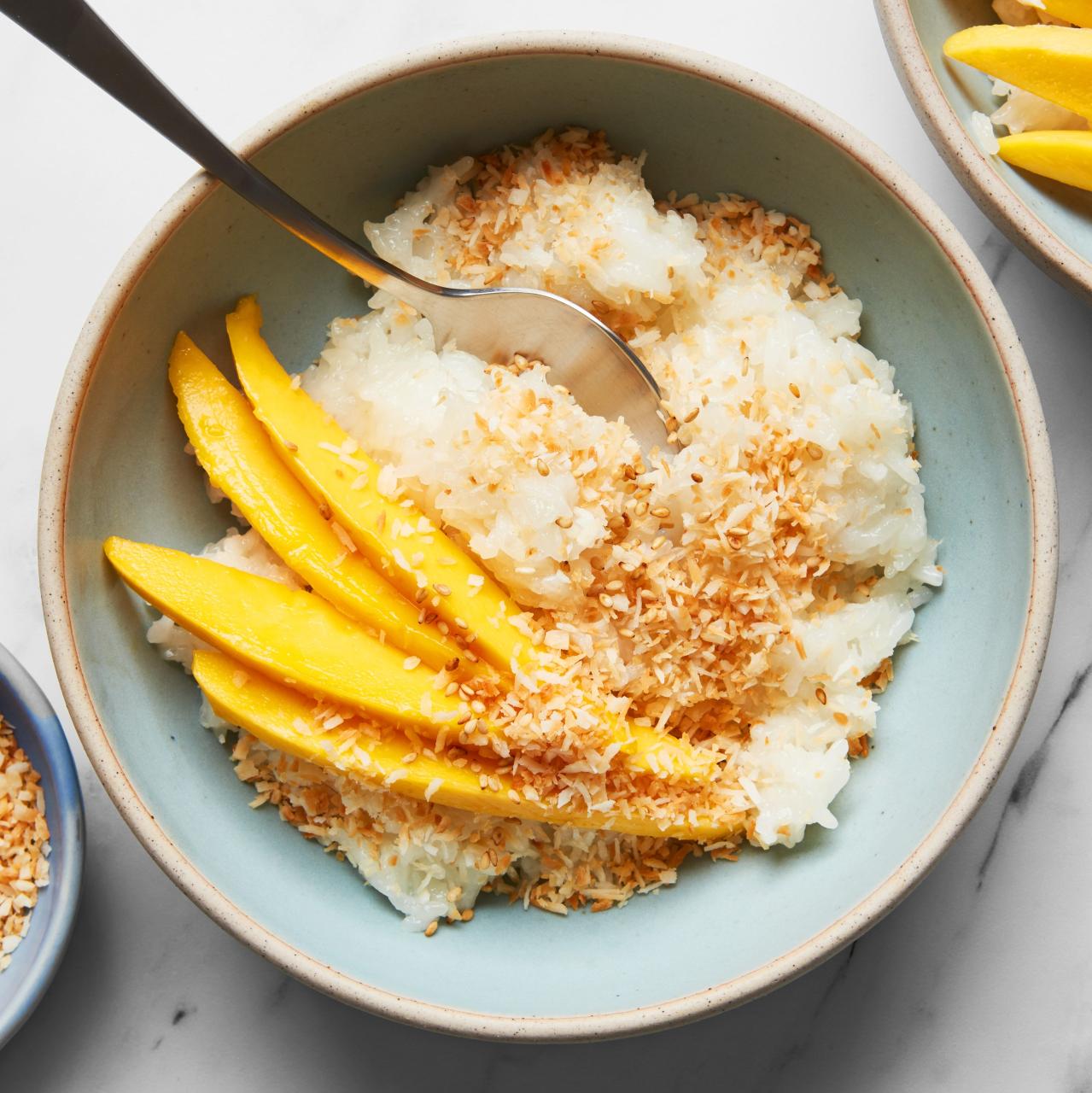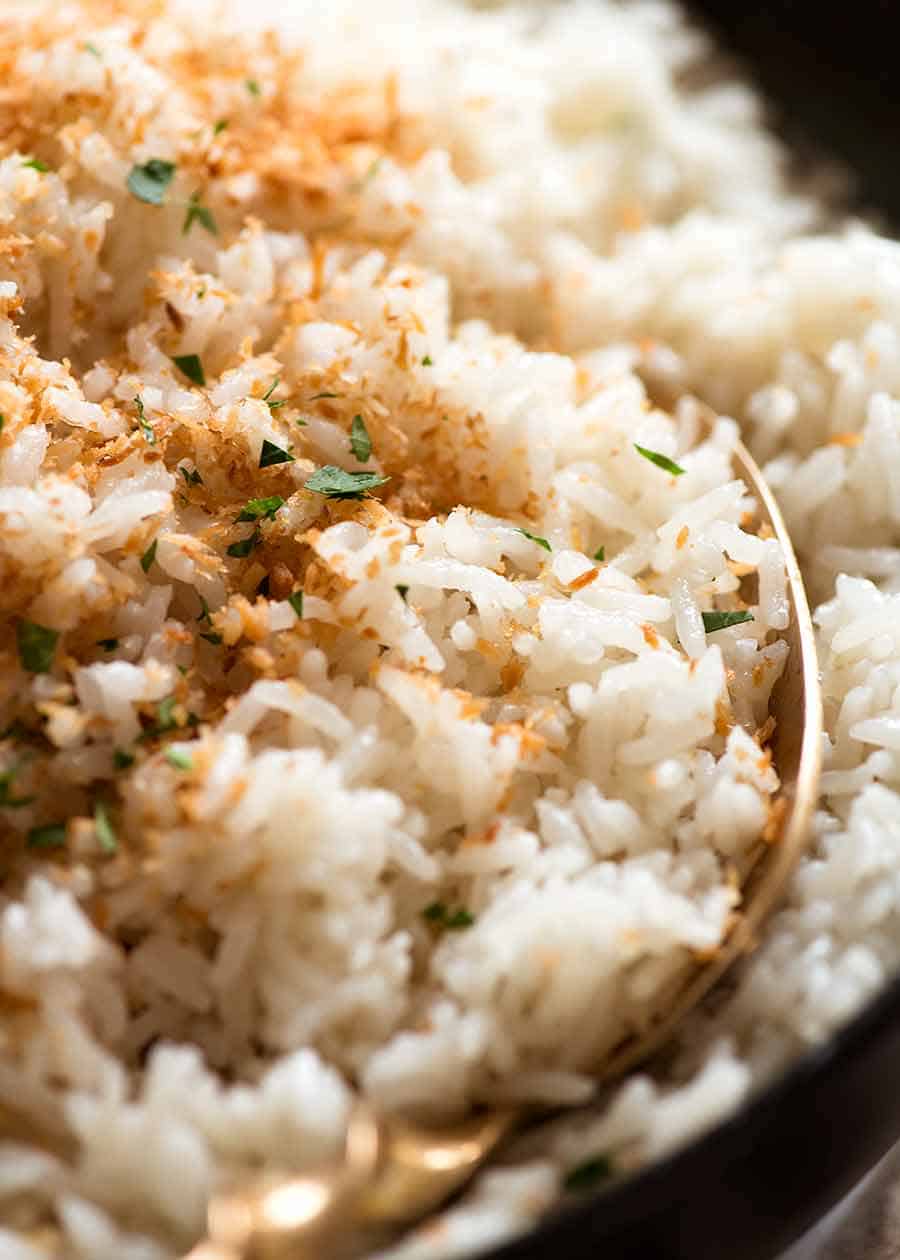Coconut rice is a delightful South Indian culinary creation that has, much like lemon rice, traversed beyond its regional roots to be adopted, enjoyed and adapted across various cuisines globally. As with lemon rice, coconut rice is also often made using pre-cooked or leftover rice, making it a quick and economical dish that transforms simple ingredients into a comforting and aromatic meal.
This dish begins with cooking the rice until it’s fluffy—leftover rice works exceptionally well as it ensures the grains are separate and fully absorb the flavors. The magic happens during the tempering process where oil or ghee is warmed and mustard seeds, urad dal, chana dal, curry leaves, and sometimes cashews are fried until they splutter and turn golden, emanating an appetizing aroma that is quintessentially Indian.
Coconut Rice Recipe


Coconut Rice
Equipment
- 1 fork
Ingredients
- 1 cup sona masoori rice rinsed with cold water, drained, and cooked according to the package instructions
- 2 tablespoons coconut oil
- 1/2 teaspoon mustard seeds
- 1/2 teaspoon cumin seeds
- 1 teaspoon husked whole black lentils
- 1 teaspoon Bengal gram
- 2 curry leaf sprigs
- 1/2 teaspoon asafoetida
- 1 dried Guntur chile halved
- 2 green chiles finely chopped
- 5 whole cashews
- 1 tablespoon peanuts
- 1 cup shredded fresh coconut or frozen, thawed to room temperature
- 11/2 teaspoons salt
- 1 tablespoon chopped fresh cilantro
Instructions
- Spread the cooked rice on a plate, fluff it with a fork, and set aside.
- In a large pan or wok over medium heat, heat the coconut oil.
- Add the mustard seeds, cumin seeds, black lentils, Bengal gram, curry leaves, and asafoetida. Cook until the mustard seeds begin to sputter, about 1 minute.
- Add the Guntur chile, green chiles, cashews, and peanuts. Cook for about 1 minute until the nuts turn light brown.
- Reduce the heat to low and add the coconut and salt. Roast the coconut with the spices for about 5 minutes. Turn off the heat. Add the coconut mixture to the rice and stir until mixed thoroughly.
- Stir in the cilantro.
Notes
Cooking Tips about Coconut Rice

- Rice Selection: Opt for rice varieties such as Jasmine or Basmati for their fragrant and non-sticky qualities once cooked. These types of rice result in fluffy grains that are perfect for absorbing the coconut flavor.
- Rinsing the Rice: Make sure to rinse the rice a few times in cold water until the water runs clear. This removes excess starch and prevents the rice from becoming gummy during cooking.
- Proportion of Coconut Milk: For that rich coconut flavor, use a combination of coconut milk and water to cook the rice. The typical ratio is one part rice to one part liquid, but check the rice packaging for specific instructions as the ratio can vary depending on the rice type.
- Tempering Spices: Start by tempering your spices in oil or ghee. Common spices include mustard seeds, urad dal, chana dal, and curry leaves. Wait for the mustard seeds to pop and the dals to turn a golden-brown color to ensure they release their full flavors into the oil.
- Using Fresh Coconut: Grating fresh coconut is recommended for the best flavor and texture, but if unavailable, unsweetened desiccated coconut can be a good alternative. However, fresh coconut gives it an authentic, fresher taste that’s hard to replicate.
- Cooking the Coconut: If you’re using fresh grated coconut, lightly sauté it in the tempered spices just enough to warm through and release the oils without browning it, as you want to maintain its tender bite.
- Adding the Rice: After the tempering and coconut are prepared, add the rinsed and drained rice to the pot, stir it to coat with the oil and spices, and then add your liquids.
- Gentle Simmer: Cook the rice on a low to medium flame. Once the coconut milk-water mixture comes to a boil, reduce to a simmer, cover the pot, and let the rice cook until all the liquid is absorbed.
- Resting Time: After the rice is cooked, let it sit covered for about 10 minutes before fluffing. This allows the rice to set and the flavors to meld together.
- Optional Garnishes: To enhance the dish further, you can add fried cashews or a squeeze of lime juice for additional depth of flavor.
Serving suggestions about Coconut Rice

- Curries: Serve the coconut rice with a spicy curry, such as chicken, fish, or vegetable curry. The rich flavors of the spices in the curry will complement the subtle sweetness of the coconut.
- Grilled Proteins: Pair it with grilled meats like chicken, prawns, or fish, which can be marinated in spices that align with the tropical taste of coconut rice.
- Papadums or Pappadams: Offer crispy papadums on the side for a contrast in texture against the soft rice.
- Tropical Fruit Salsas: Accompany the coconut rice with a fresh tropical fruit salsa made from mango, pineapple, or papaya, which can add a zesty and sweet edge.
- Vegetable Stir-Fry: A side of stir-fried vegetables seasoned with soy sauce and a hint of ginger can balance the meal both nutritionally and flavor-wise.
- Chutneys and Pickles: Serve with a selection of chutneys or pickles for a burst of tang and spice, complimenting the creaminess of the rice.
- Raita: A cooling cucumber raita or a tomato and onion raita provides a nice contrast to the warm and creamy rice.
- Roasted Nuts: Top the coconut rice with roasted cashews or almonds, which will add a delightful crunch and a nutty flavor.
- Fresh Herbs: Garnish with fresh cilantro or mint for an extra layer of freshness and color.
- Lentil Dishes: Dal tadka or any lentils based dish complements coconut rice well, adding protein and making it a more substantial meal.
Top 5 FAQs about Coconut Rice

- What type of rice is best for making coconut rice? For coconut rice, fragrant rice varieties such as Jasmine or Basmati are often recommended due to their ability to become fluffy and absorb the flavors well without becoming sticky. These types of rice enhance the natural fragrance and richness of the coconut, contributing to the overall sensory experience of the dish.
- How do you get the perfect flavor of coconut in the rice? To achieve the rich coconut flavor, use a combination of coconut milk and water to cook the rice. The typical ratio is equal parts rice and liquid, but this can vary depending on the absorption qualities of different rice types. The addition of fresh grated coconut during the tempering process intensifies the nutty, sweet taste of the dish.
- Can coconut rice be prepared with any other additional ingredients for varied tastes? Absolutely! Coconut rice can be personalized by adding a variety of other ingredients. Some variations include green chilies for a spicy kick, a sprinkle of sugar for mild sweetness, or a touch of lime juice for some acidity to balance the flavors. Other additions could include toasted cashews for crunch, fried onions for a savory note, or spices like cardamom or cloves for a more complex taste.
- How important is the tempering process in making coconut rice? The tempering process is crucial as it builds the base flavor of the dish. By frying mustard seeds, urad dal, chana dal, curry leaves, and sometimes nuts like cashews in oil or ghee until they pop and turn golden, a unique depth of flavor is achieved. This tempered mix not only infuses the oil with aromatic Indian flavors but also spreads evenly throughout the rice when mixed together.
- Is coconut rice suitable for those with dietary restrictions? Coconut rice can be a suitable dish for various dietary restrictions. It is gluten-free and vegetarian. For those who eat a vegan diet, using oil instead of ghee for the tempering will keep the dish plant-based. Additionally, coconut rice is quite adaptable and can be made without nuts for those with allergies.
In conclusion, coconut rice is far more than just a side dish—it’s a celebration of warmth and comfort that carries the essence of South Indian cuisine to tables around the world. It’s a culinary embrace that combines the treasures of the tropics with the staple of rice to create a dish that’s as versatile in its pairings as it is robust in its flavors.

Leave a Reply